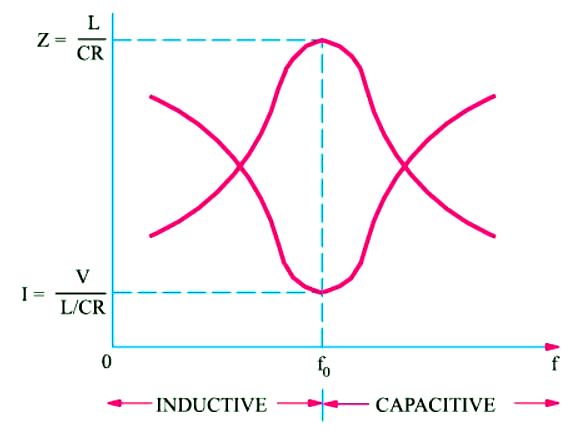Resonance in Parallel Circuits
We will consider the practical case of a coil in parallel with a capacitor to find out the Resonance in Parallel Circuits, as shown in Figure (A). Such a circuit is said to be in electrical resonance when the reactive (or wattless) component of line current becomes zero. The frequency at which this happens is known as resonant frequency. The vector diagram for this circuit is shown in Figure (A).
Net reactive or wattless component
= IC − IL sin φL
As at resonance, its value is zero, hence
IC − ILsin φL = 0 or IL sin φL = IC
Now, IL = V/Z; sin φL = XL and IC = V/XC

Hence, condition for resonance becomes

or XL × XC = Z2
Now, XL = ωL,
XC = 1/ωC

or 
or 
This is the resonant frequency and is given in Hz, R is in ohm, L is the henry and C is the farad.
If R is the negligible, then  … same as for series resonance.
… same as for series resonance.
AdBlock-2

Current at Resonance
As shown in Figure (B), since wattless component of the current is zero, the circuit current is

Putting the value of Z2 = L/C from (i) above, we get
![]()
The denominator L/CR is known as the equivalent or dynamic impedance of the parallel circuit at resonance. It should be noted that impedance is ‘resistive’ only. Since current is minimum at resonance, L/CR must, therefore, represent the maximum impedance of the circuit. In fact, parallel resonance is a condition of maximum impedance or minimum admittance.
Current at resonance is minimum, hence such a circuit (when used in radio work) is sometimes known as rejecter circuit because it rejects (or takes minimum current of) that frequency to which it resonates. This resonance is often referred to as current resonance also because the current circulating between the two branches is many times greater than the line current taken from the supply.
The phenomenon of parallel resonance is of great practical importance because it forms the basis of tuned circuits in Electronics. The variations of impedance and current with frequency are shown in Figure (B). As seen, at resonant frequency, impedance is maximum and equals L/CR. Consequently, current at resonance is minimum and is = V / (L/CR). At off-resonance frequencies, impedance decreases and, as a result, current increases as shown.
Alternative Treatment

Now, circuit would be in resonance when j-component of the complex admittance is zero i.e. when

or XLXC = R2 + XL2 = Z2 –——————as before
Talking in terms of susceptance, the above relations can be put as under : Inductive susceptance
 capacitive susceptance BC = 1/XC
capacitive susceptance BC = 1/XC
Net susceptance B = (BC − BL)
∴ Y = G + j (BC − BL) = G + jB.
The parallel circuit is said to be in resonance when B = 0.
∴ BC − BL = 0 or

The rest procedure is the same as above. It may be noted that at resonance, the admittance equals the conductance.
Read article – conductance
Visit NCERTplanet.com for NCERT solutions and Textbook downloads



